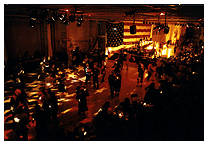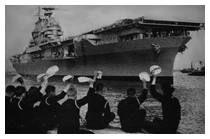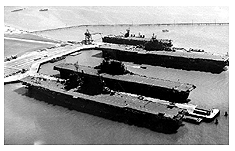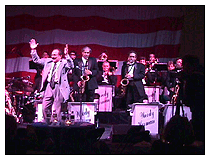|
Legacy
By The Bay: The U.S.S. Hornet
by Joya Balfour
 |
New
Years on board the Hornet.
Photo ©2001 Shirley Sachsen |
|
Along
the docks at Alameda Point, across the East Bay from San Francisco,
tall gray ships form a foreboding city of metal. They evoke a much
different time in our history: a time of conflict, of tragedy, and
of ideals we still strive for today. But tonight, Dec. 31st, 2000,
one ship plays host to a swingin' New Year's party with black-tie
revelers, Lindy Hoppers dressed in vintage navy uniforms, and WWII
veterans mingling, sharing stories and enjoying the sounds of two
fine big bands aboard the hangar deck. Exploring the flight deck
one imagines the fighter planes taking off for battle, while on
this night the fireworks exploded over nearby downtown. The U.S.S.
Hornet is a living museum not easily forgotten by those who explore
its rich history.
Who
would have thought that six years ago, it lay in the scrapper
awaiting an ignoble end?
In
early 1995, as the 50th anniversary of the end of WWII
approached, officials decided to tow the Hornet to the
Alameda Naval Air Station as part of the anniversary events.
That summer, following the visit of more than 90,000 people
who commemorated the Battle of Midway, Okinawa, V-J Day
and others, the Aircraft Carrier Hornet Foundation (ACHF)
was created to restore the ship to its former glory.
 |
The U.S.S. Hornet coming home.
Photo Courtesy U.S.S. Hornet Museum |
|
The
U.S.S. Hornet CV-12, the eighth ship of its name in American naval
history, carries an impressive legacy: survivor of 59 air attacks
but never hit, destroyer of 1,410 Japanese aircraft and recipient
of nine battle stars and the Presidential Unit citation for her
service in WWII. The Hornet's keel was laid in August 1942 and commissioned
just 15 months later. Leaving Pearl Harbor in March 1944, she spent
the next 18 months at sea, much of it within miles of the Japanese
islands. The Hornet conducted strikes in the Marianas, at Iwo Jima,
the Western Carolinas, the Philippines, Indonesia and on Tokyo-the
first carrier strikes ever on the city. By September of that same
year, hers was the top fighter squadron in the Pacific, with the
most victories and the most "ace" pilots (men who scored
five or more aerial triumphs in a single day). Following a much-celebrated
homecoming on July 8, 1945, at NAS Alameda, the Hornet sailed back
to the South Pacific to bring home servicemen from Pearl Harbor
and Guam.
 |
U.S.
Carriers Saratoga, Enterprise, Hornet and San Jacinto at
Alameda (1945).
Photo Courtresy U.S.S. Hornet Museum |
|
The
Hornet was decommissioned in 1947 and modernized four years later,
only to remain relatively inactive for 15 years. In 1969, following
three major electrical, structural and technological upgrades, she
was selected to serve as the Prime Recovery Ship for the Apollo
11 and 12 lunar landing missions. A largely unknown fact was that
the Hornet, and not NASA, provided guidance and tracking of the
astronauts' recovery-ultimately resting within one mile (Apollo
11) and one half-mile (Apollo 12) of the splashdown sites.
Designated
a State Historic Landmark in 1999, the Hornet now serves as a
naval historical and technology education center, as well as a
platform for ceremonial events. Thousands of Navy and Marine Corps
veterans, many of whom served on the battleship, have visited
the Hornet to take part in memorial services and reunions. The
ACHF's oral history department has interviewed countless veterans
to preserve their stories on video. The Hornet Museum includes
aircraft displays, histories of the Navy and Marine Corps in the
Pacific and Far East, Allied P.O.W.s, espionage and fleet activities,
and the origins of naval aviation.
 |
The
Woody Herman Orchestra
Photo ©2001 Shirley Sachsen |
|
To
raise money for the ongoing restoration of the ship, Melissa and
Alan McKean of the ACHF came up with the idea for a USO-themed big
band dance on the carrier itself-an ideal location to bring swing-era
music back to life for a larger audience. Since the first dance
was held in April 1999, the recurring event, dubbed A Dancer's Delight,
has featured the orchestras of Count Basie, Les Brown, Woody Herman,
Artie Shaw, Jimmy Dorsey, and local favorite Lavay Smith & Her
Red Hot Skillet Lickers.
The
Hornet's next commemorative event is the dedication of the Mobile
Quarantine Facility used by the Apollo 14 crew in 1971. Dr. Edgar
Mitchell, one of the original crewmembers, will take part in this
special celebration on Friday, March 16, 2001, at 10:30 AM. On
St. Patrick's Day, the carrier will play host to the next Dancer's
Delight with two bands: The Bill Elliott Swing Orchestra and Swing
Session. Tickets are $30 and can be purchased at the Hornet Box
Office, (510) 521-8448 ext. 225, or through www.Ticketmaster.com.
Following the March 17 dance, the next scheduled event will be
The Glenn Miller Orchestra on June 2nd. For more information on
the U.S.S. Hornet, its history, preservation activities and events,
visit www.uss-hornet.org.
|










